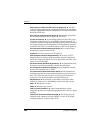
Glossary
5536 PRI RAS Communications Controller Users Guide 215
SPID (Service Profile IDentifier) An alphanumeric string that
uniquely identifies the service capabilities of an ISDN terminal. This
is an identifier that points to a particular location in the Telco's central
office switch memory where relevant details about the device are
stored. Each BRI connection can have up to two SPIDs, one for each
B channel.
SS7 (signalling System 7) This is a common channel signalling
system used to establish ISDN call functions.
SVC (Switched Virtual Circuit) Used in packet data networking
technology. Temporary virtual circuit between two users.
Switch Type The type of equipment that the telephone company
uses to provide you with ISDN service.
Synchronous Data Link Control (SDLC) A discipline conforming
to subsets of the Advanced Data Communications Control Procedures
(ADCCP) of the American National Standards Institute (ANSI) and
High-level Data Link Control (HDLC) of the International Organiza-
tion for Standardization.
Used for managing synchronous code-transparent, serial-by-bit infor-
mation transfer over a link connection. Transmission exchanges may
be duplex or half-duplex over switched or nonswitched links. The con-
figuration of the link connection may be point-to-point, multi-point, or
loop.
Contrast with binary synchronous communication.
Synchronous transmission A data transmission scheme where the
interval between transmitted characters is fixed so that start and stop
bits are not required. In contrast with asynchronous transmissions, syn-
chronous transmissions are guaranteed a specific percentage of band-
width on the network medium.
TCP/IP (Transmission Control Protocol/Internet Protocol) Proto-
col for internetwork routing and reliable message delivery. TCP/IP
functions at the 3rd and 4th layers of the Open Systems Interconnec-
tion model.
IP is the low level protocol for the TCP/IP protocol set. IP provides
packet delivery services between nodes. On the same level as IP are
ARP and RARP.
TCP is a reliable stream-delivery, virtual circuit connection-oriented
protocol that runs on top of IP. Telnet, FTP, and login use TCP connec-
tions.


















